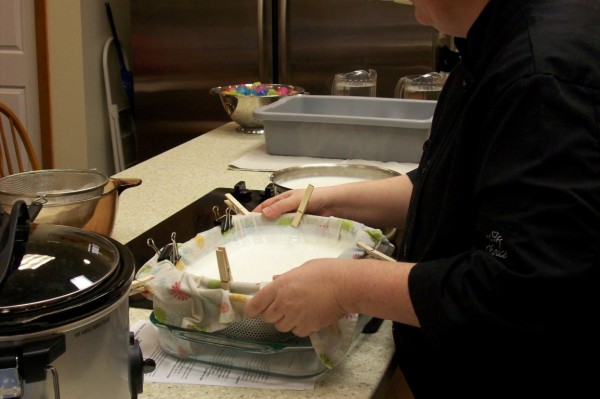
What is Yoghurt?
Yoghurt is a living food. It is the result of fermentation processes of bacteria, usually Lactobacillus bulgaricus and Streptococcus thermophilus, which transform liquid milk into a custard like, slightly sour food. The fermentation process is when the bacteria convert the sugars in the milk into lactic acid. It’s this acid that gives yogurt its characteristic tang and coagulates the liquid into the thick and creamy form. If you respect the fact that yogurt comes about from living processes, you will eliminate most of the trouble areas in making it.
What can you make yogurt from?
1. Any milk – mostly cow and goat in this area but around the world, it can be sheep, water buffalo, yak, etc.
2. Milk substitutes – soy milk, coconut milk, almond milk.
The key point is that the milk or milk substitute needs to have sugars in it, so if using a milk substitute, make sure it has some type of sugar (and not artificial sweetener) in it. Animal milks have naturally have sugar (lactose).
Equipment
1. Large pot with a heavy bottom.
2. Stem thermometer that reads from 0 to 90° C – (32 to 190° F) – these are readily available at Home Hardware,
Canadian Tire or any kitchen supply store or outlet.
3. Crock pot, or large stoneware bowl, or sterilized Mason jars.
4. A warm place – about 38-40°C (100°F). Options are an oven with a proofing setting, an oven with a working light.
If using the crockpot, skip this step. You have the warm spot.
5. Large bath towels/sheets.

| Servings |
litres
|
- 2 litres milk it doesn’t matter if it is full fat homogenized, 2% or skim. You can also use cream. NOTE: Avoid “boxes” of product that have been “UHT” treated. If it is shelf stable at room temperature, it won’t make yogurt.
- 2 tbsp starter culture Either keep some from your previous batch (best if used within 5-7 days) or buy a commercial plain, yogurt that has LIVE culture in it. Locally available brands include Liberte.
- 1/4 - 1/2 cup dry milk powder completely optional
Ingredients
|

|
- Set the crockpot to heat on “Low”.
- Pour 2 litres of milk into large, heavy bottom pot.
- Using medium heat and stirring frequently, heat milk until it reaches 84°C (185°F) – “frothing temperature”.
- Place pot into sink of cold water, filling sink until the water level comes roughly half way up the side.
- Continue stirring until milk cools to 40-45° C (105-115° F). This is very important! Milk temperatures over 48° C (120°F) will kill the bacteria culture.
- UNPLUG the crockpot and add milk to the crockpot.
- Stir in 2 Tablespoons (30 ml) of yogurt culture – don’t be tempted to add more. It will make your yogurt bitter.
- Cover crockpot and wrap in towels. Make sure crockpot is unplugged.
- Let sit for 6-8 hours undisturbed. Make note of how long you left it because that will tell you what time frame your family likes best. The longer it sits, the more “tart” it becomes
- After fermentation, Test your yogurt. It might be a bit thin and watery for your tastes. If this is the case, line a colander with a clean smooth surface cloth (kitchen towel, t-shirt, muslin “jelly bag”). Cheesecloth is too porous for this use. Fasten the cloth with clothespins. Ladle the yogurt into the colander and let it sit over a collection pot for several hours. Ideally, this should be refrigerated. If your yogurt is to your liking, put into an airtight container and store in the fridge for 1-2 weeks. If the yogurt is too thick for your tastes, take some of the liquid in the bottom of the collection container (whey) and mix it back in.
Just Don’t Throw Out That Whey !!!
Alternative uses for Whey
1. Soup stocks – use this in your favourite recipes instead of plain water.
2. Use in bread, pancake, quick bread recipes instead of buttermilk.
3. Protein shakes and smoothies – this is “whey powder” in its natural form.
4. Gardener alert – if you have problems with “powdery mildew” on cucumber, squash or pea leaves, spraying the
leaves with whey will change the acidity of the leaf surface, discouraging the mildew.
a. Lower garden soil pH for your acid loving plants (like blueberries and tomatoes). Strain the whey very
well and pour onto the soil of your acid-lovers.
5. Use as a starter for lacto-fermentation projects
6. Feed to animals – chicken and pigs love it, although your lactose-intolerant cat won’t so much.
7. Drink it up – perhaps an acquired taste but for the record, it makes an awesome lemonade.
8. Bathe in it – haven’t tried this personally but it’s supposed to soften your skin like nothing else. Also can be used as a hair conditioner.










Off